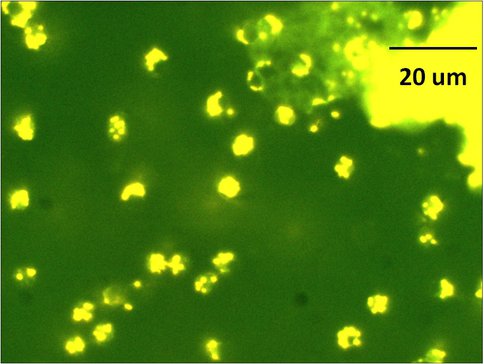2011 Annual Science Report
 Arizona State University
Reporting | SEP 2010 – AUG 2011
Arizona State University
Reporting | SEP 2010 – AUG 2011
Stoichiometry of Life, Task 4: Biogeochemical Impacts on Planetary Atmospheres
Project Summary
Oxygenation of Earth’s early atmosphere must have involved an efficient mode of carbon burial. In the modern ocean, carbon export of primary production is dominated by fecal pellets and aggregates produced by the animal grazer community. But during most of Earth history the oceans were dominated by unicellular, bacteria-like organisms (prokaryotes) causing a substantially altered biogeochemistry. In this task we experiment with the marine cyanobacterium Synechococcus sp. as a model organism and test its aggregation and sinking speed as a function of nutrient (nitrogen, phosphorus, iron) limitation. We have found so far that aggregation and sinking of these minute cyanobacteria is influenced by the concentration of nutrients in the growth medium.
Project Progress
We have grown the cyanobacterium Synechococcus sp. WH8102 as a model organism for the study of aggregation and EPS production by early marine cyanobacteria in different nutrient conditions to simulate nitrate, phosphate and iron limitation. During this past year, we have refined our methods for characterizing and quantifying exopolymeric substances (EPS) from liquid cultures of these cyanobacteria. We have used the Phenol-Sulfuric Acid (PSA) test, which colorimetrically measures all carbohydrates in a given sample, in addition to the Alcian Blue (AB) test to quantify acid polysaccharide (APS) production by the Synechococcus over time. APS are a “sticky” component of EPS and are hypothesized to be important in cell aggregation. We performed dialysis to remove dissolved ions, which interfere with the AB dyes before running the AB test and calculating APS values per sample from a xanthan gum standard curve. We are also currently working on quantifying TEP (Transparent Exopolymeric Particles) which are the particulate fraction of ABS and considered the matrix of aggregates. We have designed additional experiments to enhance aggregation using roller tanks and subsequently determined sinking rates using settling columns.
Our results so far show:
1. Synechococcus growth exhibits a broad tolerance to strongly reduced nitrate and phosphate conditions, but is strongly inhibited by limited iron availability.
2 Unlike total carbohydrate concentration, APS concentration per cell increased during the exponential growth phase.
3. We find that in nitrate limited cells, fewer aggregates form but these aggregates are larger and have a higher sinking speed compared to cells grown under optimal nitrate concentrations.
Plans for the coming project year include optimizing the measurements and experiments to be able to prepare a publication on the results of this study as well as run model simulations of the carbon cycle in the Proterozoic ocean using parameters obtained from the laboratory experiments.
Synechococcus aggregates retained on a 5 um pore-size filter
-
PROJECT INVESTIGATORS:
-
PROJECT MEMBERS:
Ariel Anbar
Co-Investigator
Watson Gregg
Co-Investigator
Wei Deng
Postdoc
Stephen Romaniello
Graduate Student
Kimberly Mohabir
Undergraduate Student
-
RELATED OBJECTIVES:
Objective 4.1
Earth's early biosphere.
Objective 4.2
Production of complex life.
Objective 5.2
Co-evolution of microbial communities
Objective 6.1
Effects of environmental changes on microbial ecosystems
Objective 7.2
Biosignatures to be sought in nearby planetary systems
